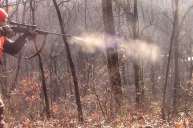Are you a beginner whitetail deer hunter? Don't miss these helpful tips.
If you're going deer hunting in North America, chances are you'll be hunting whitetail deer. It's easily the most popular form of hunting this part of the world has to offer, and rightfully so.
However, whether you're planning to hunt deer on private or public land, it won't be as easy as you might think. Some people even go years without shooting a deer on private land because they make simple mistakes.
Here are some tips you'll want to remember before you head to your hunting area for deer season this year.
Keep it legal
Before you even step foot outside the door, check with your local fish and wildlife agency to see when deer hunting season begins and ends.
Depending on the health and population of the state's herd, deer season can begin in early fall and end in late winter. You'll also want to make sure you know the limit of kills per hunter per day.
Keep in mind, the firearm you choose can also limit your hunting seasons. Bows and special firearms (usually muzzleloaders) often have different seasons assigned to them than the regular "rifle" seasons. Regulations on the type of ammunition used on deer are enforced as well.
You'll also want to make sure to obtain the proper hunting license from your state's wildlife agency.
Choose your hunting strategy
While the end result is ideally the same, there are multiple processes by which you can hunt and kill whitetails.
The most common way is by using a stand in a tree or a tower where you wait from a high vantage point for the deer to come to you. This is called stand hunting. The deer are usually attracted by planting (or in some states where it's legal, spreading) enticing food for them to eat, often called food plots.
During breeding seasons, hunters can use female scent to attract bucks to their stand's area. Patience and stealth are critical for this kind of hunting strategy.
Of course, there's more than one way to skin a cat, and the same goes for hunting deer.

Via wikimedia
Still hunting involves moving through the woods slowly on foot, following and tracking deer. Hunters take their time, stop frequently to listen and read signs to tell them where the big bucks are.
Tracking skills and knowing what to listen for are important in this method. Spot-and-stalk hunting is similar in that you slowly stalk the deer once you've spotted them.
Flushing deer from cover is known as a deer drive. This requires multiple hunters moving in a strategic way to flush deer out of the woods, and ideally other hunters waiting in the most likely exit routes.
Choose your tools wisely
Each weapon has pros and cons. Study them in depth before making your purchase.
You'll also want to take it out for practice at a shooting range before going whitetail deer hunting for the first time.
Are you going to use a bow, a crossbow, a rifle, a shotgun, a handgun or a muzzleloader? Some offer you more early-season opportunities, where some feature more power and accuracy.
In addition to your weapon of choice, make sure to bring the proper tools to aid in the hunt. Don't forget deer calls, camouflage clothing, treestands or blinds, and proper footwear.
Always make sure you check with your local wildlife agency for hunting rules and regulations.
NEXT: 8 DEER SIGNS EVERY HUNTER SHOULD RECOGNIZE
WATCH




